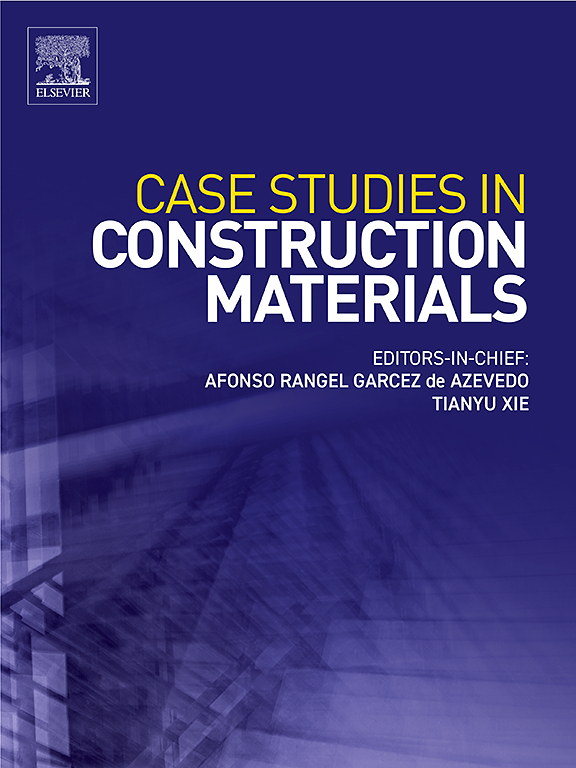Experimental study on sulfate corrosion behavior in water saturated PMPC paste and effect of W/C
IF 6.6
2区 工程技术
Q1 CONSTRUCTION & BUILDING TECHNOLOGY
引用次数: 0
Abstract
The paper investigates the sulfate corrosion behavior in potassium magnesium phosphate cement (PMPC) paste immersed in a 5 % Na2SO4 solution and effect of W/C. The conclusions are as follows: the concentration of sulfate ions decreases significantly with increasing erosion depth, the PMPC specimen with large W/C (P1) exhibited a higher content of SO₄²⁻ at the same depth compared to the PMPC specimen with small W/C (P0). Both the SO₄²⁻penetration depth and the SO₄²⁻ content inside PMPC specimen gradually increase with erosion ages. when soaked for 360 days, the measured erosion depth (h0) in the P1 specimen is 1.43 times that of the P0 specimen, and the SO₄²⁻ content at a depth of 2 mm is 1.11 times that of the P0 specimen. The relationship between the diffusion depth x (mm) of the SO₄²⁻ and the SO₄²⁻ content c (x, t) in PMPC specimens is well described by a polynomial with R2 ≥ 0.999. The surface sulfate content (cs (0, t)) gradually increases with soaking time (t). The cs (0, t) of P1 specimens is significantly larger than that of P0 specimens, and its calculated erosion depth of the SO₄²⁻ (h00) exceeds that in P0 specimens. After 360 days of immersion, the cs (0, t) of the P1 specimen is slightly larger than that of the P0 specimen, the h00 of P1 and P0 specimens is 14 mm and 19 mm, respectively. The diffusion coefficient of SO₄²⁻ (D) in PMPC specimens is on the order of 10⁻⁷ mm²/s (1/10 D of Portland cement concrete reported in previous studies). The D first increases and then decreases with t. At the same soaking age, the D of P1 specimens is significantly larger than that of P0 specimens. Specifically, the D of P1 specimens is 1.65 times that of P0 specimens when the soaking age is 360 days. As the immersing age increases, the strengths of PMPC test pieces first increase and then decrease. After immersing in the solution for 360 days, the strength residual rate of P0 test pieces is higher than 95 %, while the strength residual rate of P1 test pieces, though lower than that of P0, is still greater than 90 %. The development trend of the total porosity, diffusion coefficient and strength of PMPC specimens with different sulfate solution soaking ages is consistent.
水饱和PMPC膏体硫酸盐腐蚀行为及W/C影响试验研究
研究了磷酸钾镁水泥(PMPC)膏体在5 % Na2SO4溶液中的硫酸盐腐蚀行为及W/C的影响。结果表明:随着侵蚀深度的增加,硫酸盐离子的浓度显著降低,大W/C (P1)的PMPC试样在相同的深度上比小W/C (P0)的PMPC试样表现出更高的SO₄²⁻含量。随着侵蚀时间的增加,PMPC样品内的SO₄²⁻含量逐渐增加。浸泡360 d后,P1试样的腐蚀深度(h0)是P0试样的1.43倍,2 mm深度处的硫酸钾²⁻含量是P0试样的1.11倍。在PMPC样品中,SO₄²⁻的扩散深度x (mm)与SO₄²⁻含量c (x, t)之间的关系可以用R2≥ 0.999的多项式来描述。表面硫酸盐含量(cs (0, t))随着保温时间(t)逐渐增加。P1样品的cs (0, t)明显大于P0样品,其计算的SO₄²⁻(h00)侵蚀深度超过P0样品。浸泡360 d后,P1试样的cs (0, t)略大于P0试样,P1和P0试样的h00分别为14 mm和19 mm。SO₄²⁻(D)在PMPC试样中的扩散系数约为10⁻⁷mm²/s(先前研究中报道的波特兰水泥混凝土的1/10 D)。D随时间先增大后减小,相同浸泡时间下,P1试样的D显著大于P0试样。其中,浸泡时间为360 D时,P1试样的D是P0试样的1.65倍。随着浸泡时间的增加,PMPC试件的强度先增大后减小。在溶液中浸泡360天后,P0试件的强度残余率高于95 %,P1试件的强度残余率虽低于P0,但仍大于90 %。不同硫酸盐溶液浸泡年龄的PMPC试样的总孔隙率、扩散系数和强度的发展趋势是一致的。
本文章由计算机程序翻译,如有差异,请以英文原文为准。
求助全文
约1分钟内获得全文
求助全文
来源期刊

Case Studies in Construction Materials
Multiple-
CiteScore
7.60
自引率
19.40%
发文量
842
审稿时长
63 days
期刊介绍:
Case Studies in Construction Materials provides a forum for the rapid publication of short, structured Case Studies on construction materials. In addition, the journal also publishes related Short Communications, Full length research article and Comprehensive review papers (by invitation).
The journal will provide an essential compendium of case studies for practicing engineers, designers, researchers and other practitioners who are interested in all aspects construction materials. The journal will publish new and novel case studies, but will also provide a forum for the publication of high quality descriptions of classic construction material problems and solutions.
 求助内容:
求助内容: 应助结果提醒方式:
应助结果提醒方式:


